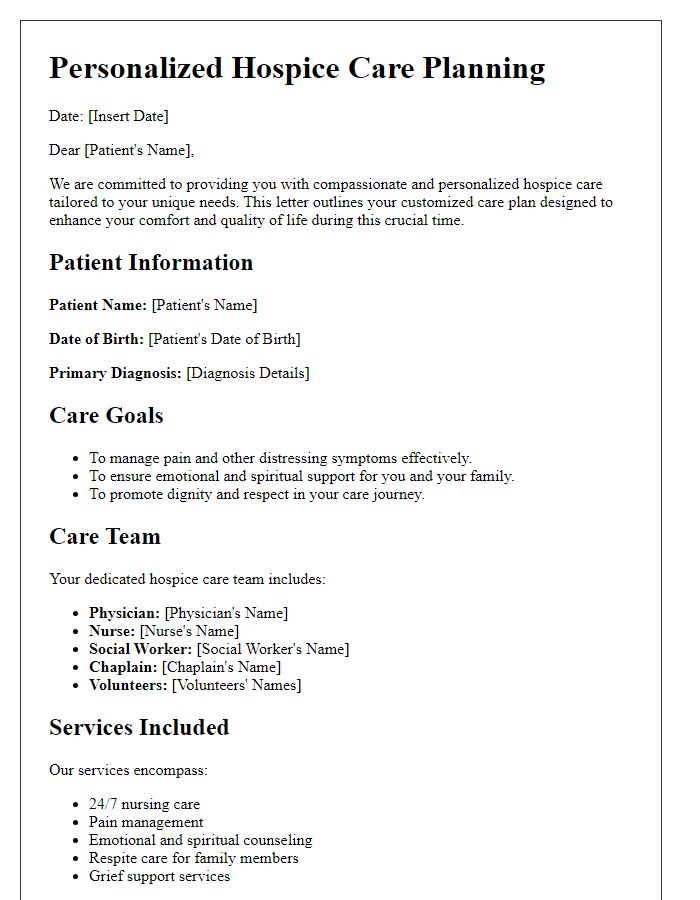When it comes to end-of-life care planning, having a supportive framework can make all the difference. It's a sensitive topic, yet an essential one for ensuring that wishes and preferences are honored during such a challenging time. Patients, families, and healthcare providers can benefit from clear communication and understanding throughout this process. Let's dive deeper into how to effectively navigate this journey togetherâread on to explore our comprehensive guide!

Clarity and Compassionate Tone
End-of-life care planning involves thoughtful discussions about the preferences of individuals nearing life's final stages. Patients, such as those with terminal illnesses like cancer or advanced heart disease, often require clarity regarding their treatment options. Advance directives, legal documents specifying medical care preferences, play an essential role in ensuring healthcare providers respect the patient's wishes. Communication with family members, including children and spouses, is crucial to foster understanding and support. Pain management, a primary focus during palliative care, aims to enhance comfort and quality of life. Healthcare teams, often comprising doctors, nurses, and social workers, collaborate to create personalized care plans that prioritize dignity and peace. Locations such as hospice facilities provide specialized support, ensuring patients receive the necessary emotional and spiritual care as they transition through this important phase of life.
Patient's Personal Wishes and Preferences
Patient's personal wishes and preferences regarding end-of-life care are crucial for ensuring dignity and comfort during the final stages of life. This planning process often involves discussing advanced directives, such as living wills, which outline specific medical treatments the patient desires or wishes to avoid. Key elements include preferences for life-sustaining treatments, such as cardiopulmonary resuscitation (CPR) or mechanical ventilation, and the use of palliative care options to manage pain and enhance quality of life. Additionally, consideration of the preferred location for end-of-life care--whether at home, in a hospice setting, or in a hospital--plays a vital role in aligning care with the patient's values. Open discussions with family members, healthcare providers, and palliative care specialists can facilitate meaningful conversations, ensuring that the patient's wishes are respected and integrated into their care plan. Personal beliefs, cultural considerations, and spiritual needs are significant factors that should also be documented to guide decision-making during critical moments.
Legal and Ethical Considerations
End-of-life care planning is critical for ensuring that patients receive compassionate and appropriate care according to their wishes. Legal considerations encompass advance directives, such as living wills and durable powers of attorney for healthcare, which guide medical decisions when patients can no longer speak for themselves. Ethical considerations involve respecting patient autonomy, ensuring informed consent, and addressing issues of beneficence (acting in the patient's best interest) versus nonmaleficence (avoiding harm). Jurisdictions like California have specific laws, such as the End of Life Option Act, allowing terminally ill patients to choose physician-assisted dying, reflecting broader societal debates on morality and personal choice. Healthcare providers, including nurses and physicians, must navigate complex emotions and potential conflicts arising from family dynamics, cultural values, and differing opinions regarding the appropriateness of interventions at this vulnerable stage of life. Regular communication and clear documentation of patient preferences are essential to honoring their choices and ensuring lawful compliance within the healthcare framework.
Involvement of Family and Healthcare Team
End-of-life care planning is a critical process involving family members and a comprehensive healthcare team to ensure that preferences and wishes are respected. The family, often including immediate relatives such as spouses, children, and siblings, plays a vital role in communicating emotional and practical concerns, helping to advocate for patient wishes. Healthcare professionals such as physicians, nurses, and social workers must collaborate in this sensitive stage, assessing the patient's medical condition, pain management needs, and emotional support requirements. Regular multidisciplinary meetings are essential, allowing the integration of varied perspectives and expertise, ensuring a holistic approach to care. Additionally, discussions surrounding advanced directives, palliative care options, and hospice services are crucial components that help guide the decision-making process in alignment with the patient's values and goals.
Resources and Support Services Information
A letter template designed for patient end-of-life care planning serves as an essential tool facilitating clear communication regarding preferences and decisions surrounding end-of-life issues. This template includes sections for documenting personal wishes, appointed healthcare proxies, and specific medical directives, ensuring patients' desires are respected. Important resources such as hospice services, palliative care options, and legal support information are provided to guide families through this sensitive process. Additionally, community support services, including grief counseling and spiritual care, offer emotional and psychological assistance, fostering an environment of compassion and understanding during challenging times.













Comments